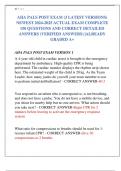1|Page
AHA PALS POST EXAM (3 LATEST VERSIONS)
NEWEST 2024-2025 ACTUAL EXAM COMPLETE
150 QUESTIONS AND CORRECT DETAILED
ANSWERS (VERIFIED ANSWERS) |ALREADY
GRADED A+
AHA PALS POST EXAM VERSION 1
A 4-year-old child in cardiac arrest is brought to the emergency
department by ambulance. High-quality CPR is being
performed. The cardiac monitor displays the rhythm strip shown
here. The estimated weight of the child is 20 kg. As the Team
Leader, how many joules do you tell your team member to use
to perform initial defibrillation? - CORRECT ANSWER-40 J
You respond to an infant who is unresponsive, is not breathing,
and does not have a pulse. You do not have a mobile device, and
you shout for nearby help but no one arrives. What action should
you take next? - CORRECT ANSWER-Begin CPR for 2
minutes before leaving to activate the emergency response
system
What ratio for compressions to breaths should be used for 1-
rescuer infant CPR? - CORRECT ANSWER-Give 30
compressions to 2 breaths
,2|Page
A 3-year-old boy is brought to the emergency department by his
mother. He is lethargic, with retractions and nasal flaring. He
has a respiratory rate of 70/min, with warm extremities and brisk
capillary refill. Which immediate life-threatening condition
could this child's condition most likely progress to if left
untreated? - CORRECT ANSWER-Respiratory failure
You are evaluating a 10-year-old child who is febrile and
tachycardic. The child's capillary refill time is 5 seconds. What
parameter will determine if the child is in compensated shock? -
CORRECT ANSWER-Blood pressure
An 18-month old has had vomiting and diarrhea for the past 2
days; the mother brings him to the emergency department
because he is becoming more lethargic. What diagnostic test
should you order first? - CORRECT ANSWER-Blood glucose
You are caring for a 3-month-old boy with a 2-day history of
fever, vomiting, and diarrhea. His parents state that he has been
sleeping much more. His heart rate is 190/min, temperature is
38.3°C (101°F), blood pressure is 59/29 mm Hg, respiratory rate
is 70/min and shallow, and oxygen saturation is 94% on 100%
oxygen. His capillary refill time is 4 to 5 seconds, and he has
mottled, cool extremities. The infant weighs 6 kg. What
assessment finding indicates that the infant has hypotensive
shock? - CORRECT ANSWER-Blood pressure
,3|Page
You are caring for a 3-month-old boy with a 2-day history of
fever, vomiting, and diarrhea. His parents state that he has been
sleeping much more. His heart rate is 190/min, temperature is
38.3°C (101°F), blood pressure is 59/29 mm Hg, respiratory rate
is 70/min and shallow, and oxygen saturation is 94% on 100%
oxygen. His capillary refill time is 4 to 5 seconds, and he has
mottled, cool extremities. The infant weighs 6 kg. On the basis
of this infant's presentation, what type of shock does this infant
have? - CORRECT ANSWER-Hypovolemic
You are caring for a 3-month-old boy with a 2-day history of
fever, vomiting, and diarrhea. His parents state that he has been
sleeping much more. His heart rate is 190/min, temperature is
38.3°C (101°F), blood pressure is 59/29 mm Hg, respiratory rate
is 70/min and shallow, and oxygen saturation is 94% on 100%
oxygen. His capillary refill time is 4 to 5 seconds, and he has
mottled, cool extremities. The infant weighs 6 kg. You have
decided that this infant needs fluid resuscitation. How much
fluid should you administer? - CORRECT ANSWER-20 mL/kg
normal saline
What abnormality helps identify children with acute respiratory
distress caused by lung tissue disease? - CORRECT ANSWER-
Crackles
, 4|Page
You are caring for a 9-month-old girl who has increased work of
breathing, a fever, and a cough. On assessment, you find an alert
infant with stridor and retractions. The infant's Sp O2 is 94%.
On auscultation, the lungs are clear bilaterally. What is the most
likely cause of this infant's respiratory distress? - CORRECT
ANSWER-Upper airway obstruction
You are caring for a 9-month-old girl who has increased work of
breathing, a fever, and a cough. On assessment, you find an alert
infant with stridor and retractions. The infant's Sp O2 is 94%.
On auscultation, the lungs are clear bilaterally. What medication
should you administer first? - CORRECT ANSWER-
Epinephrine, nebulized
What condition is characterized by a prolonged expiratory phase
and wheezing? - CORRECT ANSWER-Lower airway
obstruction
A 5-year-old child is brought to the emergency department by
ambulance after being involved in a motor vehicle collision.
You are using the primary assessment to evaluate the child.
When assessing the child's neurologic status, you note that he
has spontaneous eye opening, is fully oriented, and is able to
follow commands. How would you document this child's AVPU
(Alert, Voice, Painful, Unresponsive) Pediatric Response Scale
finding? - CORRECT ANSWER-Alert




